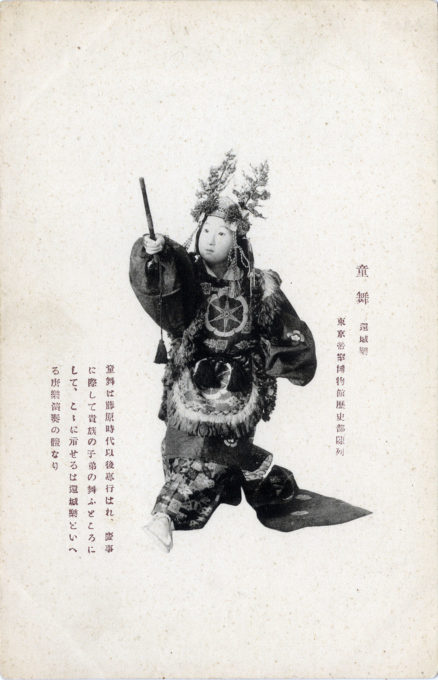
Child dance, “performed” by a child mannequin, Imperial Household Museum, Ueno, Tokyo, c. 1930. The dance displayed is from the Kanjo raku or “return to the castle music” dance and was performed since the Nara period (710-794) by the children of nobility on festive occasions. Published by the Imperial Museum (Ueno).
See also:
Sansa Shigure Dancers, c. 1930-40.
Japanese master swordsman Hibino “Raifu” Masayoshi, c. 1910.
“Dainichi-do bugaku (Vairocana Temple Dance) is a yearly set of nine sacred ritual dances and music, named for the imperial palace ensemble performances, ‘bugaku’, and from the palace’s ensemble’s visit to Hachimantai, Kazuno District, Akita Prefecture, during the reconstruction of the local shrine pavilion, ‘Dainichido’, in the early eighth century, and their teaching of dances to the locals.
“Instruments used include the flute and taiko. The order and number of dances has changed over time, with the current order of seven dances being the ‘Gongen-mai’, ‘Koma-mai’, ‘Uhen-mai’, ‘Tori-mai’, ‘Godaison-mai’, ‘Kōshō-mai’, and ‘Dengaku-mai’ dances. Masks include representations of shishi and Vairocana [cosmic Buddha].
“The dances have a 1300-year history, from the Nara period (710-794 C.E.), and though interrupted for nearly sixty years in the late eighteenth century, the dances, some of which may include children or masks, are still practiced on January second from sunrise to noon in shrines throughout communities in Osato, Azukisawa, Nagamine, and Taniuchi, including Hachimantai.
“Yamaji Kōzō dates Dainichido bugaku as arising during and after the Nara (710 to 794 C.E.) and mid-Heian periods (794 to 1185 C.E.), after state support of Shinto temple complexes (originally ordered by Emperor Shōmu (701 – 756 C.E.) began to decline and court and temple performers took residence in local communities, which then preserved genres such as Dainichido bugaku as folk arts.”
– Wikipedia

